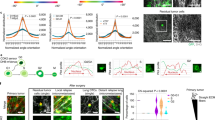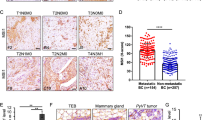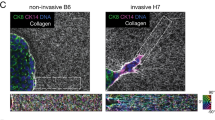Abstract
As invading breast carcinoma cells breach their underlying basement membrane, they become confronted with a dense three-dimensional reactive stroma dominated by type I collagen. To develop metastatic capabilities, invading tumor cells must acquire the capacity to negotiate this novel microenvironment. Collagen influences the fate of epithelial cells by inducing apoptosis. However, the mechanisms used by invading tumor cells to evade collagen-induced apoptosis remain to be defined. We demonstrate that membrane type-1 matrix metalloproteinase (MT1-MMP/MMP-14) confers breast cancer cells with the ability to escape apoptosis when embedded in a collagen gel and after orthotopic implantation in vivo. In the absence of MMP-14-dependent proteolysis, type I collagen triggers apoptosis by inducing the expression of the pro-apoptotic Bcl-2-interacting killer in luminal-like breast cancer cells. These findings reveal a new mechanism whereby MMP-14 activity promotes tumor progression by circumventing apoptosis.
This is a preview of subscription content, access via your institution
Access options
Subscribe to this journal
Receive 50 print issues and online access
$259.00 per year
only $5.18 per issue
Buy this article
- Purchase on Springer Link
- Instant access to full article PDF
Prices may be subject to local taxes which are calculated during checkout








Similar content being viewed by others
References
Bao W, Strömblad S . (2004). Integrin alphav-mediated inactivation of p53 controls a MEK1-dependent melanoma cell survival pathway in three-dimensional collagen. J Cell Biol 167: 745–756.
Barbolina MV, Stack MS . (2008). Membrane type 1-matrix metalloproteinase: substrate diversity in pericellular proteolysis. Semin Cell Dev Biol 19: 24–33.
Barkan D, El Touny LH, Michalowski AM, Smith JA, Chu I, Davis AS et al. (2010). Metastatic growth from dormant cells induced by a col-I-enriched fibrotic environment. Cancer Res 70: 5706–5716.
Bindels S, Mestdagt M, Vandewalle C, Jacobs N, Volders L, Noel A et al. (2006). Regulation of vimentin by SIP1 in human epithelial breast tumor cells. Oncogene 25: 4975–4985.
Birkedal-Hansen H . (1987). Catabolism and turnover of collagens: collagenases. Methods Enzymol 144: 140–171.
Bissell MJ, Rizki A, Mian IS . (2003). Tissue architecture: the ultimate regulator of breast epithelial function. Curr Opin Cell Biol 15: 753–762.
Blick T, Hugo H, Widodo E, Waltham M, Pinto C, Mani SA et al. (2010). Epithelial mesenchymal transition traits in human breast cancer cell lines parallel the CD44(hi/)CD24 (lo/-) stem cell phenotype in human breast cancer. J Mammary Gland Biol Neoplasia 15: 235–252.
Butler GS, Dean RA, Tam EM, Overall CM . (2008). Pharmacoproteomics of a metalloproteinase hydroxamate inhibitor in breast cancer cells: dynamics of membrane type 1 matrix metalloproteinase-mediated membrane protein shedding. Mol Cell Biol 28: 4896–4914.
Chinnadurai G, Vijayalingam S, Rashmi R . (2008). BIK, the founding member of the BH3-only family proteins: mechanisms of cell death and role in cancer and pathogenic processes. Oncogene 27 (Suppl 1): S20–S29.
Eccles SA, Box GM, Court WJ, Bone EA, Thomas W, Brown PD . (1996). Control of lymphatic and hematogenous metastasis of a rat mammary carcinoma by the matrix metalloproteinase inhibitor batimastat (BB-94). Cancer Res 56: 2815–2822.
Egeblad M, Werb Z . (2002). New functions for the matrix metalloproteinases in cancer progression. Nat Rev Cancer 2: 161–174.
Figueira RC, Gomes LR, Neto JS, Silva FC, Silva ID, Sogayar MC . (2009). Correlation between MMPs and their inhibitors in breast cancer tumor tissue specimens and in cell lines with different metastatic potential. BMC Cancer 9: 20.
Fujisaki H, Hattori S . (2002). Keratinocyte apoptosis on type I collagen gel caused by lack of laminin 5/10/11 deposition and Akt signaling. Exp Cell Res 280: 255–269.
Galluzzi L, Aaronson SA, Abrams J, Alnemri ES, Andrews DW, Baehrecke EH et al. (2009). Guidelines for the use and interpretation of assays for monitoring cell death in higher eukaryotes. Cell Death Differ 16: 1093–1107.
Giam M, Huang DC, Bouillet P . (2008). BH3-only proteins and their roles in programmed cell death. Oncogene 27 (Suppl 1): S128–S136.
Gingras D, Béliveau R . (2010). Emerging concepts in the regulation of membrane-type 1 matrix metalloproteinase activity. Biochim Biophys Acta 1803: 142–150.
Hanahan D, Weinberg RA . (2000). The hallmarks of cancer. Cell 100: 57–70.
Hanahan D, Weinberg RA . (2011). Hallmarks of cancer: the next generation. Cell 144: 646–674.
Henriet P, Zhong ZD, Brooks PC, Weinberg KI, DeClerck YA . (2000). Contact with fibrillar collagen inhibits melanoma cell proliferation by up-regulating p27KIP1. Proc Natl Acad Sci USA 97: 10026–10031.
Hiraoka N, Allen E, Apel IJ, Gyetko MR, Weiss SJ . (1998). Matrix metalloproteinases regulate neovascularization by acting as pericellular fibrinolysins. Cell 95: 365–377.
Hotary K, Allen E, Punturieri A, Yana I, Weiss SJ . (2000). Regulation of cell invasion and morphogenesis in a three-dimensional type I collagen matrix by membrane-type matrix metalloproteinases 1, 2, and 3. J Cell Biol 149: 1309–1323.
Hotary K, Li XY, Allen E, Stevens SL, Weiss SJ . (2006). A cancer cell metalloprotease triad regulates the basement membrane transmigration program. Genes Dev 20: 2673–2686.
Hotary KB, Allen ED, Brooks PC, Datta NS, Long MW, Weiss SJ . (2003). Membrane type I matrix metalloproteinase usurps tumor growth control imposed by the three-dimensional extracellular matrix. Cell 114: 33–45.
Hotary KB, Yana I, Sabeh F, Li XY, Holmbeck K, Birkedal-Hansen H et al. (2002). Matrix metalloproteinases (MMPs) regulate fibrin-invasive activity via MT1-MMP-dependent and -independent processes. J Exp Med 195: 295–308.
Hur J, Chesnes J, Coser KR, Lee RS, Geck P, Isselbacher KJ et al. (2004). The Bik BH3-only protein is induced in estrogen-starved and antiestrogen-exposed breast cancer cells and provokes apoptosis. Proc Natl Acad Sci USA 101: 2351–2356.
Hynes RO . (2009). The extracellular matrix: not just pretty fibrils. Science 326: 1216–1219.
Kalluri R, Zeisberg M . (2006). Fibroblasts in cancer. Nat Rev Cancer 6: 392–401.
Kao J, Salari K, Bocanegra M, Choi YL, Girard L, Gandhi J et al. (2009). Molecular profiling of breast cancer cell lines defines relevant tumor models and provides a resource for cancer gene discovery. PLoS One 4: e6146.
Kauppila S, Stenback F, Risteli J, Jukkola A, Risteli L . (1998). Aberrant type I and type III collagen gene expression in human breast cancer in vivo. J Pathol 186: 262–268.
Kessenbrock K, Plaks V, Werb Z . (2010). Matrix metalloproteinases: regulators of the tumor microenvironment. Cell 141: 52–67.
Kim TY, Zhong S, Fields CR, Kim JH, Robertson KD . (2006). Epigenomic profiling reveals novel and frequent targets of aberrant DNA methylation-mediated silencing in malignant glioma. Cancer Res 66: 7490–7501.
Koshikawa N, Mizushima H, Minegishi T, Eguchi F, Yotsumoto F, Nabeshima K et al. (2011). Proteolytic activation of heparin-binding EGF-like growth factor by membrane-type matrix metalloproteinase-1 in ovarian carcinoma cells. Cancer Sci 102: 111–116.
Lehti K, Valtanen H, Wickstrom SA, Lohi J, Keski-Oja J . (2000). Regulation of membrane-type-1 matrix metalloproteinase activity by its cytoplasmic domain. J Biol Chem 275: 15006–15013.
Liotta LA, Kohn EC . (2001). The microenvironment of the tumour-host interface. Nature 411: 375–379.
Lomonosova E, Ryerse J, Chinnadurai G . (2009). BAX/BAK-independent mitoptosis during cell death induced by proteasome inhibition? Mol Cancer Res 7: 1268–1284.
Lopez-Otin C, Hunter T . (2010). The regulatory crosstalk between kinases and proteases in cancer. Nat Rev Cancer 10: 278–292.
Mathai JP, Germain M, Shore GC . (2005). BH3-only BIK regulates BAX, BAK-dependent release of Ca2+ from endoplasmic reticulum stores and mitochondrial apoptosis during stress-induced cell death. J Biol Chem 280: 23829–23836.
McGowan PM, Duffy MJ . (2008). Matrix metalloproteinase expression and outcome in patients with breast cancer: analysis of a published database. Ann Oncol 19: 1566–1572.
Mizushima H, Wang X, Miyamoto S, Mekada E . (2009). Integrin signal masks growth-promotion activity of HB-EGF in monolayer cell cultures. J Cell Sci 122: 4277–4286.
Montgomery AM, Reisfeld RA, Cheresh DA . (1994). Integrin alpha v beta 3 rescues melanoma cells from apoptosis in three-dimensional dermal collagen. Proc Natl Acad Sci USA 91: 8856–8860.
Morrison CJ, Overall CM . (2006). TIMP independence of matrix metalloproteinase (MMP)-2 activation by membrane type 2 (MT2)-MMP is determined by contributions of both the MT2-MMP catalytic and hemopexin C domains. J Biol Chem 281: 26528–26539.
Nagase H, Visse R, Murphy G . (2006). Structure and function of matrix metalloproteinases and TIMPs. Cardiovasc Res 69: 562–573.
Naumann U, Schmidt F, Wick W, Frank B, Weit S, Gillissen B et al. (2003). Adenoviral natural born killer gene therapy for malignant glioma. Hum Gene Ther 14: 1235–1246.
Noël A, Jost M, Maquoi E . (2008). Matrix metalloproteinases at cancer tumor-host interface. Semin Cell Dev Biol 19: 52–60.
Ohuchi E, Imai K, Fujii Y, Sato H, Seiki M, Okada Y . (1997). Membrane type 1 matrix metalloproteinase digests interstitial collagens and other extracellular matrix macromolecules. J Biol Chem 272: 2446–2451.
Okada A, Bellocq JP, Rouyer N, Chenard MP, Rio MC, Chambon P et al. (1995). Membrane-type matrix metalloproteinase (MT-MMP) gene is expressed in stromal cells of human colon, breast, and head and neck carcinomas. Proc Natl Acad Sci USA 92: 2730–2734.
Ota I, Li XY, Hu Y, Weiss SJ . (2009). Induction of a MT1-MMP and MT2-MMP-dependent basement membrane transmigration program in cancer cells by Snail1. Proc Natl Acad Sci USA 106: 20318–20323.
Perumal S, Antipova O, Orgel JP . (2008). Collagen fibril architecture, domain organization, and triple-helical conformation govern its proteolysis. Proc Natl Acad Sci USA 105: 2824–2829.
Polyak K, Weinberg RA . (2009). Transitions between epithelial and mesenchymal states: acquisition of malignant and stem cell traits. Nat Rev Cancer 9: 265–273.
Rodríguez D, Morrison CJ, Overall CM . (2010). Matrix metalloproteinases: what do they not do? New substrates and biological roles identified by murine models and proteomics. Biochim Biophys Acta 1803: 39–54.
Rouzier R, Perou CM, Symmans WF, Ibrahim N, Cristofanilli M, Anderson K et al. (2005). Breast cancer molecular subtypes respond differently to preoperative chemotherapy. Clin Cancer Res 11: 5678–5685.
Sabeh F, Li XY, Saunders TL, Rowe RG, Weiss SJ . (2009a). Secreted versus membrane-anchored collagenases: relative roles in fibroblast-dependent collagenolysis and invasion. J Biol Chem 284: 23001–23011.
Sabeh F, Ota I, Holmbeck K, Birkedal-Hansen H, Soloway P, Balbin M et al. (2004). Tumor cell traffic through the extracellular matrix is controlled by the membrane-anchored collagenase MT1-MMP. J Cell Biol 167: 769–781.
Sabeh F, Shimizu-Hirota R, Weiss SJ . (2009b). Protease-dependent versus -independent cancer cell invasion programs: three-dimensional amoeboid movement revisited. J Cell Biol 185: 11–19.
Sarri D, Rodriguez-Pinilla SM, Hardisson D, Cano A, Moreno-Bueno G, Palacios J . (2008). Epithelial-mesenchymal transition in breast cancer relates to the basal-like phenotype. Cancer Res 68: 989–997.
Sato H, Takino T, Miyamori H . (2005). Roles of membrane-type matrix metalloproteinase-1 in tumor invasion and metastasis. Cancer Sci 96: 212–217.
Sodek KL, Brown TJ, Ringuette MJ . (2008). Collagen I but not Matrigel matrices provide an MMP-dependent barrier to ovarian cancer cell penetration. BMC Cancer 8: 223.
Sorlie T, Perou CM, Tibshirani R, Aas T, Geisler S, Johnsen H et al. (2001). Gene expression patterns of breast carcinomas distinguish tumor subclasses with clinical implications. Proc Natl Acad Sci USA 98: 10869–10874.
Sounni NE, Devy L, Hajitou A, Frankenne F, Munaut C, Gilles C et al. (2002). MT1-MMP expression promotes tumor growth and angiogenesis through an up-regulation of vascular endothelial growth factor expression. FASEB J 16: 555–564.
Sounni NE, Roghi C, Chabottaux V, Janssen M, Munaut C, Maquoi E et al. (2004). Up-regulation of vascular endothelial growth factor-A by active membrane-type 1 matrix metalloproteinase through activation of Src-tyrosine kinases. J Biol Chem 279: 13564–13574.
Sternlicht MD, Werb Z . (2001). How matrix metalloproteinases regulate cell behavior. Annu Rev Cell Dev Biol 17: 463–516.
Sturm I, Stephan C, Gillissen B, Siebert R, Janz M, Radetzki S et al. (2006). Loss of the tissue-specific proapoptotic BH3-only protein Nbk/Bik is a unifying feature of renal cell carcinoma. Cell Death Differ 13: 619–627.
Taube JH, Herschkowitz JI, Komurov K, Zhou AY, Gupta S, Yang J et al. (2010). Core epithelial-to-mesenchymal transition interactome gene-expression signature is associated with claudin-low and metaplastic breast cancer subtypes. Proc Natl Acad Sci USA 107: 15449–15454.
Yamada KM, Cukierman E . (2007). Modeling tissue morphogenesis and cancer in 3D. Cell 130: 601–610.
Zou Y, Peng H, Zhou B, Wen Y, Wang SC, Tsai EM et al. (2002). Systemic tumor suppression by the proapoptotic gene bik. Cancer Res 62: 8–12.
Acknowledgements
We thank M Fringuellini, P Gavitelli, E Konradovski and N Lefin for their excellent technical assistance. This work was supported by grants from the FP7-HEALTH-2007-A Proposal No 201279 ‘MICROENVIMET’, the Fonds de la Recherche Scientifique Médicale, the Fonds de la Recherche Scientifique - FNRS (FRS-FNRS, Belgium), the Foundation against Cancer (foundation of public interest, Belgium), the CGRI-FNRS-INSERM Coopération, the Fonds spéciaux de la Recherche (University of Liège), the Centre Anticancéreux près l’Université de Liège, the Fonds Léon Fredericq (University of Liège), the Direction Générale Opérationnelle de l’Economie, de l’Emploi et de la Recherche from the SPW (Région Wallonne, Belgium), the Fonds Social Européen (FSE, Belgium), the Fonds d’Investissements de la Recherche Scientifique (FIRS, CHU Liège, Belgium), the Interuniversity Attraction Poles Program - Belgian Science Policy (Brussels, Belgium). EM is a Research Associate from the F.R.S.-FNRS (Belgium).
Author information
Authors and Affiliations
Corresponding author
Ethics declarations
Competing interests
The authors declare no conflict of interest.
Additional information
Supplementary Information accompanies the paper on the Oncogene website
Supplementary information
Rights and permissions
About this article
Cite this article
Maquoi, E., Assent, D., Detilleux, J. et al. MT1-MMP protects breast carcinoma cells against type I collagen-induced apoptosis. Oncogene 31, 480–493 (2012). https://doi.org/10.1038/onc.2011.249
Received:
Revised:
Accepted:
Published:
Issue Date:
DOI: https://doi.org/10.1038/onc.2011.249
Keywords
This article is cited by
-
A novel cross-communication of HIF-1α and HIF-2α with Wnt signaling in TNBC and influence of hypoxic microenvironment in the formation of an organ-on-chip model of breast cancer
Medical Oncology (2023)
-
The role of collagen in cancer: from bench to bedside
Journal of Translational Medicine (2019)
-
Matrix Metalloproteinase-14 Is a Negative Prognostic Marker for Patients with Gastric Cancer
Digestive Diseases and Sciences (2013)
-
Plasma matrix metalloproteinases and postmenopausal breast cancer risk: a nested case–control study in the Multiethnic Cohort study
Breast Cancer Research and Treatment (2012)



